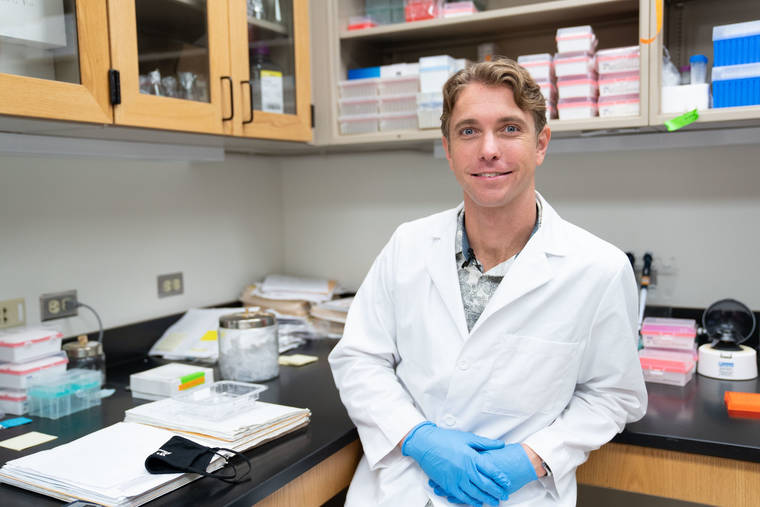Jesse Owens was just 17 when he decided to devote his life to gene therapy research.
Now the youngest full-time faculty member at John A. Burns School of Medicine’s Institute for Biogenesis Research, Owens — who grew up in Keaukaha — is working to make gene therapy safer with the help of funding from the National Institutes of Health.
During his senior year of high school, the 2003 Hilo High graduate, now 36, sailed around the world, taking classes aboard a sailboat as part of a study program.
It was then that Owens became interested in the idea of adding new genes into a genome.
“I was really interested in the idea that you could deliver a gene into an animal, whether that be a mouse, a pig or a person. … I thought that was really cool, something that could be a very powerful tool.”
He received his bachelor’s degree in molecular, cellular and developmental biology from University of California, Santa Cruz, and earned a doctorate in cell and molecular biology from the University of Hawaii at Manoa in 2014.
At UH-Manoa, he was able to work with Dr. Stefan Moisyadi, a specialist in transgenic mice.
“So from there, I kind of refocused my goal into making it so when you deliver a gene into a person or organism, the gene goes in safely and not randomly,” he said. “It goes into a specific location.”
Owens recently was awarded $2.3 million over the next five years from the NIH to develop a new and safer tool for gene therapy.
Gene therapy delivers a gene into a person to replace a mutated or broken gene to cure genetic disease, Owens explained.
According to a UH news release, the grant addresses drawbacks to current genome editing technologies that randomly insert a therapeutic gene. Sometimes, that randomly inserted gene might disrupt other genes, which could cause cancer, Owens explained.
Currently, the process is not thought of as very safe and is only used on diseases that are terminal, he said, but one of his major goals is to make gene therapy less risky, “then use gene therapy to treat more diseases.”
By the end of the five years, Owens said he hopes to have developed a new tool to deliver large pieces of DNA to a specific location in the genome and nowhere else.
“The genome we have is able to make every single protein in our body,” he said. “So the ability to bring in new pieces of DNA gives us a lot of power because we are able to potentially correct any genetic disease. So we’re not talking about curing one disease with this tool. You might be able to cure all genetic diseases. … So by making a tool, you kind of have a broader impact than if I studied one disease.”
Owens shares his alma mater with biochemist Jennifer Doudna, a 1981 Hilo High graduate and a professor at the University of California, Berkeley, who along with her research partner, Emmanuelle Charpentier, a French microbiologist, received the 2020 Nobel Prize in chemistry for their development of the CRISPR-Cas9 gene-editing tool.
“I feel like people in Hilo often don’t think they have that many opportunities, and I think that Jennifer Doudna is an example of why that’s not true,” Owens said.
“Not only is he faculty here, he got his (doctorate) here, he was trained here, he was raised on the Big Island,” Dr. Steven Ward, director of the UH Institute for Biogenesis Research, said in the news release. “He’s the product of that, and it just shows you that Hawaii can do some of the world’s greatest biomedical research.”
In addition to the NIH funding, Owens recently signed a sponsored research agreement with a private company called SalioGen Therapeutics that is specializing in nonviral gene therapies, UH said. The goal of this collaboration is to advance the tools Owens is developing in the lab into clinical-stage gene therapy candidates. Owens is the son of David Owens of Keaukaha and Peach McGuffey of Puna.
Email Stephanie Salmons at ssalmons@hawaiitribune-herald.com.




